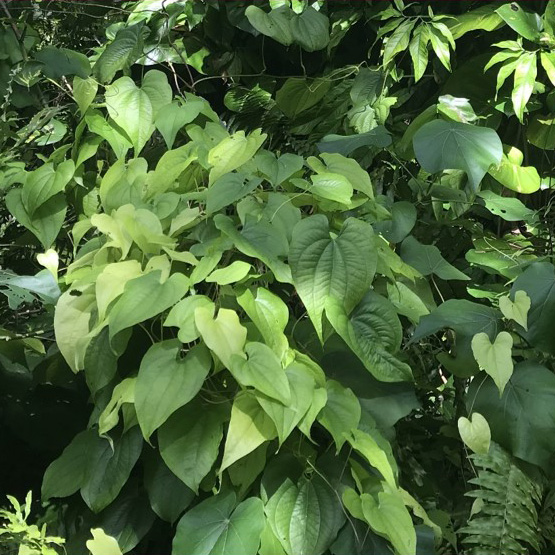Air potato (Hoi)
The origin of air potato is uncertain. Some believe that this species is native to both Asia and tropical Africa, while others believe it is only native to Asia and was introduced to Africa. Air potato is now widely naturalised in tropical and subtropical areas in the USA, the West Indies, and in the Pacific region. Air potato has become invasive in the Caribbean region, the southern USA, and on some Pacific Islands including Fiji, French Polynesia, Niue, Palau, Tonga, and Wallis and Futuna.
Edible varieties of air potato exist, particularly in India and West Africa, but the most common wild form is usually bitter and can be toxic if not prepared properly. Consequently, air potato was only ever used in the past as a famine food in the Pacific. It has been used extensively for traditional medicine in some parts of the world, but not the Pacific.

Air potato vine
Impacts
Air potato foliage dies back in the winter/dry season, but quickly regrows from the tubers a few months later. Air potato can climb tall trees and block out sunlight below. Thick mats of air potato can quickly smother native vegetation causing native plant communities and other biodiversity to decline. These changes can mean that ecosystem functioning is impaired.
Air potato can also have negative economic impacts. It can infest agricultural land, reducing crop yields. It can also clog waterways and damage infrastructure. The cost of controlling air potato can be significant.
New areas can be colonised by air potato when the bulbils are spread around by flooding or storms. The bulbils can last a long time on the ground before sprouting and starting to grow.
Control methods
Since air potato grows on and becomes entangled with other plants, including native and beneficial plants, it is difficult to apply herbicide without also killing them. Manual removal is very time consuming. The plant can quickly resprout from the network of underground tubers and grow from cut vines and bulbils which can survive a long time, even if they are buried under soil. A natural enemy is available, a beetle (Liliocheris cheni), which has been used successfully to control air potato in Florida.
![Air potato leaf beetle [Lilioceris cheni]](/assets/Discover-Our-Research/Biosecurity/pacific-weeds/Air-potato-/Air-potato-leaf-beetle-Lilioceris-cheni-sq__FillMaxWzMwMCwyMDBd.jpg)
